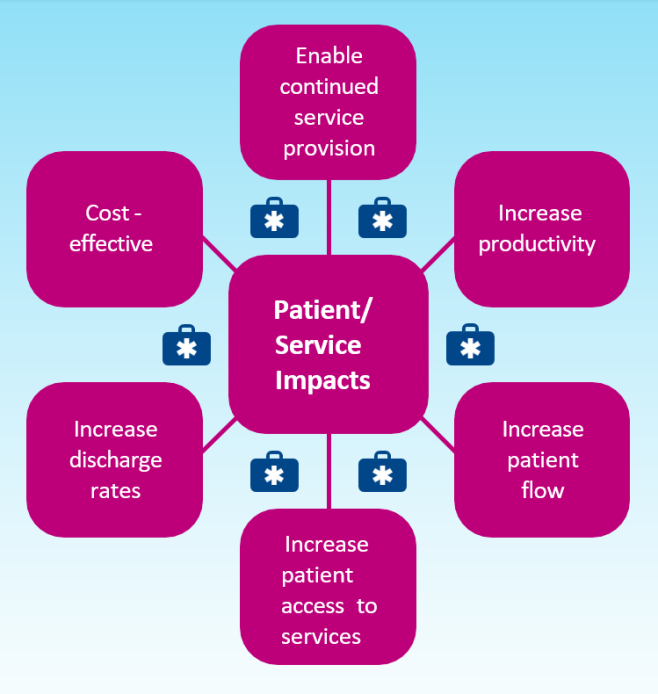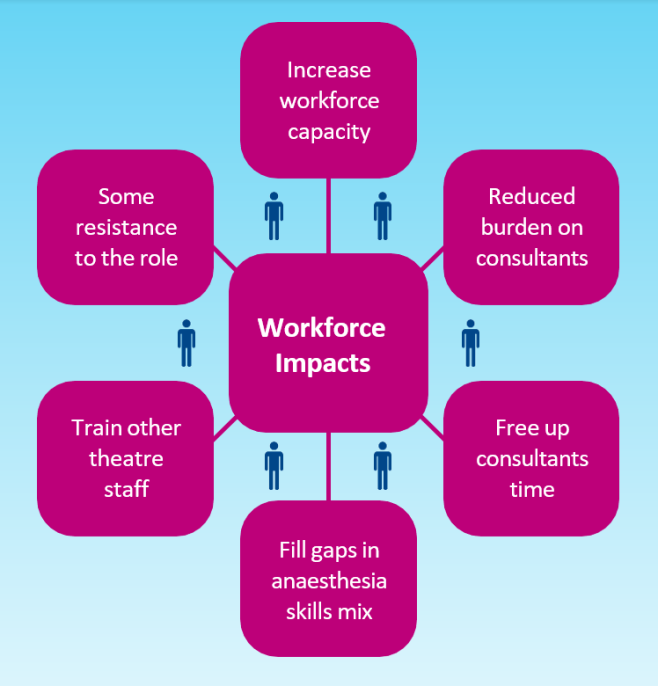You are here
Anaesthesia Associate Role Impact Case Study
Background
Anaesthesia Associates (AAs) are anaesthetic providers who work under the direction and supervision of a Consultant Anaesthetist. The AA role was first introduced in 2004 and is now established within many NHS hospitals, with approximately 160 AAs on The Royal College of Anaesthetists’ Managed Voluntary Register as of 2022. This case study provides insight into how the AA roles are typically used, and the impact of the role on NHS patients, systems, and workforce. The case study data are based on a qualitative analysis of interview data collected from 12 research participants (4 AA leads and 8 AA employers) from 8 NHS organisations across 5 NHS England regions. The data indicate that the perspectives of the leads and the employers are mostly aligned, thus the viewpoints have been combined for the purpose of this case study.
How AA roles are utilised
AAs are utilised in 1:1 (AA & consultant anaesthetist) & 2:1 (2 AAs or 1AA/1 trainee anaesthetist & consultant anaesthetist) capacities and work in a diverse range of surgical areas. They traditionally supported trauma and day surgery patient lists but many hospitals have now expanded the role so that AAs are also trained in specialist procedures. For example, AAs are now used routinely in ophthalmology to administer eye blocks. Some AAs also work outside theatre undertaking preoperative assessments and providing sedation services for interventional radiology.
Many AAs work 10-hour shifts to enable them to complete a full patient list. Some work out-of-hours or weekends to support the emergency and trauma services or more complex cases, however, many do not. This is for various reasons including lack of supervisory availability or there being an insufficient number of AAs to cover 7-day working. Many hospitals will be requiring AAs to work weekends soon to meet service needs.
The AA role is not currently regulated by the General Medical Council and AAs are unable to prescribe which limits their ability to be autonomous practitioners. Additionally, there is no clear guidance on how the scope of practice should shift with increased experience and skill acquisition. There is no national career development pathway in place for AAs.
At Leeds Teaching Hospital Trust (LTHT), AAs are trained in conscious sedation in areas such as pain management and Transcatheter aortic valve implantation. Having AAs trained in these areas has been particularly successful in freeing up consultant anaesthetist time.
“The other area we use them [AAs] is in vascular access, which has been a massive success. It wasn’t a service that was formally there before, but it sort of snowballed as we’ve been able to provide it” (Natalie Drury, Consultant Anaesthetist and Lead for Anaesthesia Associates, LTHT).
AT LTHT, training AAs to remove Hickman lines has also been a success because it means patients no longer need to wait on a surgical registrar to do this.
Impacts on patients and service provision
 The AA role is perceived to primarily exert a positive impact on patients and service provision, with the nature and extent of impact dependent upon how the role is utilised.
The AA role is perceived to primarily exert a positive impact on patients and service provision, with the nature and extent of impact dependent upon how the role is utilised.
One of the key aspects of the role is to provide flexibility to anaesthesia teams in service delivery. This enables the consultant to manage their team more effectively, reducing theatre downtime and increasing patient flow, and in some cases, helps to increase the overall productivity of the department. Impact on productivity appears to be greater when AAs are supporting with trauma lists which are subject to significant starting and stopping when consultants are on their own.
In some hospitals AAs are deployed across the whole perioperative pathway, from preassessment to following up trauma patients post operatively; they monitor patients’ fitness and optimisation for surgery and ensure they have appropriate pain relief afterwards. The data indicate that utilising AAs in this way also helps to improve patient flow and productivity.
Many AAs have been trained to administer specialist procedures which has increased patient access to services as well as patient discharge rates. For example, training AAs in vascular access, has been shown to improve the speed to which patients receive treatments such as chemotherapy, thereby reducing hospital bed days. In some hospitals, AAs have been trained to support with conscious sedation which allows more lists to be done and reduces patient waiting times.
The data suggest that AAs can, with appropriate supervision, be a cost-effective member of the theatre team. They can provide a layer of flexibility and continuity to anaesthesia departments, facilitating increased consultant availability and providing not only anaesthesia services efficiently but also services related to the speciality.
“ Having another anaesthesia provider decreases downtime between patients as there are two of us…one can be taking a patient to theatre or finishing off the anaesthesia, one could be starting the next case if staffing allows. And so, it can increase turnover, more operations can happen in a timely manner as a result of that. It's particularly useful to patients from nonelective trauma work…so, fractured neck of femur patients have better outcomes when they have a timely operation”.
Kathleen Dixon, Lead Anaesthesia Associate, University Hospitals Birmingham
“ The AAs are very predictable and what the consultant surgeons tell me is that this makes it easier to plan their list because they'll say, oh, if I've got this AA doing my list, I know that the anaesthetics are going to take 10 minutes each so I can plan how many patients to bring in if it's him. And so, they can sort of fit an extra patient on because they can rely on the system… So, I think it helps with the planning aspects of making an efficient and productive list.”
Tim Moll, Consultant Anaesthetist and Lead for Anaesthesia Associates, Sheffield Teaching Hospitals NHS Foundation Trust
Impacts on workforce
 AAs increase workforce capacity; they support the anaesthetist workforce when there are shortages and reduce the burden on consultants. A prominent theme in the data is that the AA role helps to take the pressure off medical staff without removing the higher tier of medical care. Utilising AAs in a 2:1 model appears to be particularly impactful in terms of freeing up consultants’ time. This model frees up consultants to work on other lists and in areas of greater demand, whilst reducing the likelihood of staff having to work additional hours and having to pay for locum consultants. The 2:1 model also releases consultants to undertake training and to train other theatre staff.
AAs increase workforce capacity; they support the anaesthetist workforce when there are shortages and reduce the burden on consultants. A prominent theme in the data is that the AA role helps to take the pressure off medical staff without removing the higher tier of medical care. Utilising AAs in a 2:1 model appears to be particularly impactful in terms of freeing up consultants’ time. This model frees up consultants to work on other lists and in areas of greater demand, whilst reducing the likelihood of staff having to work additional hours and having to pay for locum consultants. The 2:1 model also releases consultants to undertake training and to train other theatre staff.
Utilising AAs in a team approach in areas that require anaesthetic input can provide a more appropriate skill mix across all areas of service provision. Additionally, AAs share knowledge and provide training to all levels of the multidisciplinary team, including trainee nurses, operating department practitioners, and trainee anaesthetists. Because AAs do not typically rotate, they have an in-depth understanding of systems and processes, providing continuity to anaesthesia departments.
It is apparent that there is a level of resistance against the AA role. There are some concerns from consultants around their role changing to be less patient facing when supervising AAs. There is also a perception of increased risk related to safety and quality of service, although others believe that having an AA working under appropriate supervision can facilitate direct continuous quality control and increase safety.
Furthermore, the data suggest that many anaesthetic trainees worry that AAs will take away training and future job opportunities. Taken together, these perceptions indicate a mixed view of the role and some degree of scepticism that will need addressing in the future.
“ [AAs] are able to do innovative things like provide eye blocks. In the past, if there was no AA it had to be done by a consultant…so that's a significant saving for the whole organisation and for the department. It has allowed us to use consultants’ time in a more important role in other areas than providing those [eye] blocks which can be safely provided by an AA. This is a very significant area of improvement.”
Ganesh Gopalakrishnan, Clinical Director for Anaesthesia, Hull University Teaching Hospitals NHS Trust.
Achieving increased impact
To achieve greater impact of the AA role, the data suggest that the following are required:
- More AAs
- GMC regulation
- Ability to prescribe
- Clear guidance on scope of practice with experience
- National guidance on appraisal & revalidation
- Sharing of protocols between hospitals employing AAs
- A clear career pathway
- Building awareness of the role
- Time; employing AAs involves a cultural change for many teams